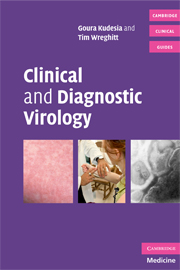Book contents
- Frontmatter
- Contents
- List of plates
- Preface
- Acknowledgements
- SECTION 1 INDIVIDUAL VIRUSES
- Introduction to virology
- 1 Adenoviruses
- 2 Arboviruses and haemorrhagic fever viruses
- 3 Cytomegalovirus (CMV)
- 4 Epstein–Barr virus (EBV)
- 5 Enteroviruses
- 6 Hepatitis A virus (HAV)
- 7 Hepatitis B and D viruses (HBV and HDV)
- 8 Hepatitis C virus (HCV)
- 9 Hepatitis E virus (HEV)
- 10 Herpes simplex virus (HSV)
- 11 Human immunodeficiency virus (HIV) and acquired immunodeficiency syndrome (AIDS)
- 12 Human herpes viruses types 6, 7 and 8 (HHV 6, 7 and 8)
- 13 Human T-cell leukaemia virus (HTLV)
- 14 Influenza viruses
- 15 Measles virus
- 16 Mumps virus
- 17 Noroviruses
- 18 Parainfluenza viruses
- 19 Papilloma and polyoma viruses
- 20 Parvovirus B19
- 21 Pox viruses
- 22 Rabies virus
- 23 Respiratory syncytial virus (RSV)
- 24 Rhinoviruses
- 25 Rotavirus
- 26 Rubella virus
- 27 SARS CoV and other coronaviruses
- 28 Varicella-zoster virus (VZV)
- SECTION 2 OTHER RELATED AGENTS
- SECTION 3 CLINICAL SYNDROMES
- SECTION 4 DIAGNOSTIC TECHNIQUES
- SECTION 5 PATIENT MANAGEMENT
- Index
- Plate section
23 - Respiratory syncytial virus (RSV)
Published online by Cambridge University Press: 07 December 2009
- Frontmatter
- Contents
- List of plates
- Preface
- Acknowledgements
- SECTION 1 INDIVIDUAL VIRUSES
- Introduction to virology
- 1 Adenoviruses
- 2 Arboviruses and haemorrhagic fever viruses
- 3 Cytomegalovirus (CMV)
- 4 Epstein–Barr virus (EBV)
- 5 Enteroviruses
- 6 Hepatitis A virus (HAV)
- 7 Hepatitis B and D viruses (HBV and HDV)
- 8 Hepatitis C virus (HCV)
- 9 Hepatitis E virus (HEV)
- 10 Herpes simplex virus (HSV)
- 11 Human immunodeficiency virus (HIV) and acquired immunodeficiency syndrome (AIDS)
- 12 Human herpes viruses types 6, 7 and 8 (HHV 6, 7 and 8)
- 13 Human T-cell leukaemia virus (HTLV)
- 14 Influenza viruses
- 15 Measles virus
- 16 Mumps virus
- 17 Noroviruses
- 18 Parainfluenza viruses
- 19 Papilloma and polyoma viruses
- 20 Parvovirus B19
- 21 Pox viruses
- 22 Rabies virus
- 23 Respiratory syncytial virus (RSV)
- 24 Rhinoviruses
- 25 Rotavirus
- 26 Rubella virus
- 27 SARS CoV and other coronaviruses
- 28 Varicella-zoster virus (VZV)
- SECTION 2 OTHER RELATED AGENTS
- SECTION 3 CLINICAL SYNDROMES
- SECTION 4 DIAGNOSTIC TECHNIQUES
- SECTION 5 PATIENT MANAGEMENT
- Index
- Plate section
Summary
The virus
Respiratory syncytial virus is a single-stranded RNA virus belonging to the family Paramyxoviridae.
Epidemiology
Route of spread
Respiratory syncytial virus is spread readily by direct contact with respiratory secretions, fomites and large droplets through the nose and eyes (but not the mouth). Nosocomial infections are common.
Prevalence
Respiratory syncytial virus has a worldwide distribution. In the developed world it occurs in epidemics in mid winter (November to February in the UK). Infection is common in young children; 70% are infected and 30% have clinical illness in their first year of life. Two per cent of infants have severe lower respiratory tract symptoms. All children are infected by 3 years of age, some having had more than one infection. Immunity is short lasting – just a few weeks or months. In families of pre-school age children as the primary case, 50% of family members will be infected. There are higher attack rates in nurseries and playschools.
Incubation period
3–6 days.
Infectious period
Children are infectious for 9 days on average, but this can be much longer.
Adults are infectious for about 2 days.
Immunocompromised patients can be infectious for several weeks.
At-risk groups
Immunocompromised patients (e.g. those with severe combined immunodeficiency syndrome, bone-marrow transplant recipients, those on chemotherapy, HIV infected patients).
- Type
- Chapter
- Information
- Clinical and Diagnostic Virology , pp. 101 - 103Publisher: Cambridge University PressPrint publication year: 2009



